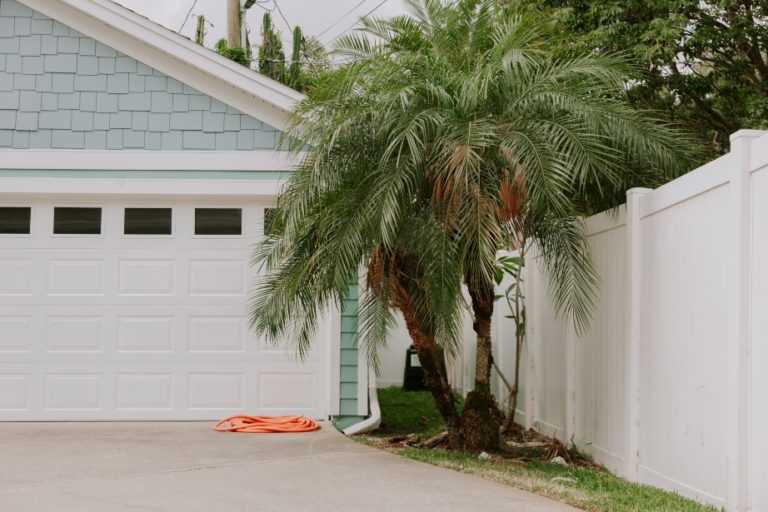When most folx buy a home, they’re interested in things like size, the type of HVAC system, and the condition of the foundation and roof. Other aspects, like the driveway and walkways, usually come as an afterthought.
But maintenance on these high-traffic areas is important. Keeping your driveway and walkways in good condition is not only a safety measure for your household, it also makes it easier to find a homeowners insurance policy. Not to mention, replacing them altogether can be costly.
We’ll walk you through the main types of driveways and their common problems, plus tips to keep them well-maintained:
Asphalt
Asphalt is a black, sticky blend of stone, sand, gravel, and oil, which roads are also made of. Driveways are paved with asphalt in layers that create a smooth and stable surface. It’s affordable, durable, and easy to maintain.
Common problems
- Cracking — Cracks may look scaly like crocodile skin, square or rectangular, or long and jagged. Generally, cracks mean there’s an issue with the base layer or the top layer of asphalt is too thin. Filling cracks is a good idea, but if the issue continues you may need a professional to repave the driveway or walkway.
- Sinking or heaving — Bumps and divots in your asphalt driveway or walkway mean there’s an issue with the base. Usually, freezing and thawing causes expansion, and shrinking leads to sinking and heaving. A pro can remove the damaged area and replace it.
- Damaged edges — Damaged edges can indicate a drainage issue, or that you’re driving too close to the edge and there isn’t proper support beneath the asphalt. Ignoring edge cracks can cause them to expand across your driveway, leading to bigger problems.
Regular maintenance
- Keep it clean — Sweep and spray down your asphalt driveways and walkways in the spring and fall. Use a driveway cleaner to remove oil stains or other fluids from vehicles.
- Patch cracks and holes — Fill cracks and holes to keep water from getting through. Hardware stores sell asphalt-based fillers. Make sure to get the stuff made specifically for asphalt.
- Reseal — Apply a new layer of sealant to your driveway and walkways every 3-5 years. Sealant helps maintain the surface and adds water resistance.
Concrete
Concrete is a blend of sand, gravel, water, and Portland cement. Concrete professionals pour wet concrete over a gravel base framed by wooden forms. They smooth it out as it dries. Most concrete driveways and walkways have expansion joints. These joints prevent cracking as the driveway expands and contracts with changing temperatures.
Common problems
- Cracking—Concrete usually cracks because of temperature changes, an issue with the base layer, pressure, or tree roots. Some surface cracking is normal with concrete, but cracks that are longer than three feet and wider than a pencil are cause for concern.
- Spalling—Spalling is when the surface of the concrete flakes off, leaving the surface rough and bumpy. It not only looks bad; it can lead to further damage down the road. It usually happens from improper installation and curing.
- Broken corners or edges— Broken edges can mean you have a drainage issue or you’re driving too close to your driveway’s edge and there isn’t proper support beath the concrete. Ignoring edge cracks can cause cracks to expand across your driveway, leading to larger issues.
Regular maintenance
- Avoid salt and puddles — Salt-based deicers and standing water can damage the surface of concrete. A damaged surface doesn’t just look bad, it can let water in and cause more damage. Avoid salting concrete driveways and walkways, and soak up puddles that last more than a day.
- Patch spalling and cracks — You can buy concrete crack fillers and concrete resurfacing products at the hardware store. You may need a caulking gun, a large squeegee, and a putty knife. Stay on top of these issues to prevent more severe damage down the road.
- Reseal — Apply a new layer of sealant to your concrete driveway and walkways every 3-5 years. Sealant helps maintain the driveway or walkway’s surface and adds water resistance.
Gravel
Gravel driveways and walkways are made of loose bits of stone. The stone is often mixed with some sand and clay and laid over a textile material to create stability. Gravel driveways are affordable and durable. They don’t crack or heave because of tree roots or freezing. While they do require regular maintenance, they’re usually easier to fix than concrete or asphalt.
Common problems
- Drainage — Low points in your driveway may collect water, and puddles on gravel will weaken it and can lead to larger problems.
- Potholes — Water also causes potholes. Once a hole forms, it’ll keep growing over time. Deep enough potholes can damage your vehicle or become safety hazards.
- Gravel displacement — Over time, gravel gets displaced by weather and regular of using the driveway or walkway. Displacement can lead to berms and ruts that can damage your vehicles or become safety hazards. It can also cause leveling issues in the driveway, which lead to drainage issues.
Regular maintenance
- Rake the surface — Rake the surface of your gravel driveway or walkway with a simple yard rake every few months. This not only keeps your driveway looking nice, but it also prevents potholes and displacement.
- Backfill potholes — Keep a pile of gravel on hand to fill potholes when they appear. Simply pour in some gravel and pack it down as you go.
- Regrade — You’ll likely need to regrade your driveway every few years or after a particularly rainy or snowy season. This job involves smoothing the driveway out and adding a few inches of new gravel. It requires a tractor or bulldozer, so budget for it ahead of time.
Pavers
Pavers are blocks laid side by side to form a stable flat surface for a driveway or walkway. They’re typically made of concrete, stone, or brick that come in a variety of styles and colors. Pavers are typically installed over a layer of sand or fine gravel, and polymetric sand or natural sand is placed in the gaps between pavers for stability.
Common problems
- Sinking or heaving — Water runoff from rain can cause the sand or gravel base beneath the pavers to become uneven. Tree roots and freezing temperatures can also cause pavers to heave or sink. Direct gutter downspouts away from driveways and walkways, and repair sunken pavers ASAP to prevent further damage.
- Weeds — Weeds typically grow through the spaces between pavers. They’re not only unsightly, but they can also cause pavers to move and open space for water to leak in. Chemical herbicides or natural solutions like vinegar and water can kill weeds. You can also dig them out and replace the sand between pavers to prevent regrowth.
- Fading and stains — Pavers naturally fade in color over time, so this is something to keep in mind when picking out the pavers for your driveway or walkway. They are also porous, so oil or other chemicals can stain them.
Regular maintenance
- Remove weeds and refill gaps — Remove weeds as they pop up between your pavers. In the spring and fall, refill the gaps with polymetric sand to prevent weeds and water damage beneath your driveway or walkway.
- Keep pavers clean — Sweep and spray down your paver driveways and walkways in the spring and fall. Use a driveway cleaner made for your specific kind of paver to remove oil stains or other fluids from vehicles.
- Reseal — Apply a new layer of sealant to your paver driveways and walkways every few years. Sealant helps maintain the driveway or walkway’s surface and adds water resistance. Make sure you get sealant designed for your specific kind of paver.
Choosing the right materials and pros
If you’re thinking about putting in or redoing an existing driveway or walkway, you have options. Before deciding, here are a few things to consider:
- The style of your home
- The climate where you live
- The amount of maintenance you want to do
- Your budget
A contractor should be able to help you make the right decision, but keep in mind they may be biased toward materials they work with. While some contractors may handle all kinds of materials, others may work with one in particular and have strong opinions about it.
Looking for more ways to keep up the outside of your home? Check out these posts:
- Dress up your porch for less than $300.
- How to raise your home value by improving your yard.




